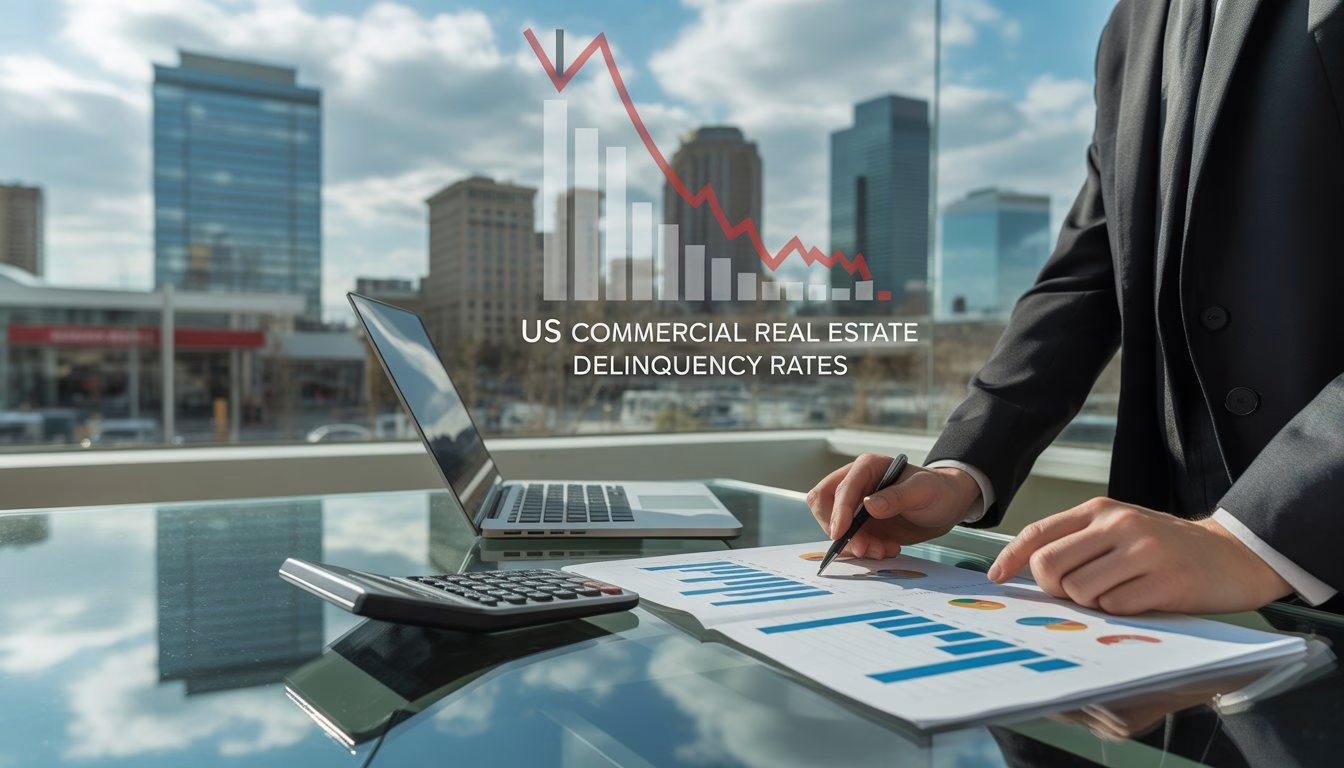US commercial real estate delinquency rates have reached concerning levels in 2025, with significant implications for investors and the broader financial market. The US office delinquency rate spiked to 8.12% in September 2025, driven largely by major defaults including a $180 million loan backing a Manhattan office building. This represents a 42 basis point increase from August, signaling mounting stress in the commercial property sector.
The challenges extend beyond office properties, as commercial property values have plunged since 2022, with office vacancies and loan delinquencies soaring. Property values have declined 18% from their peak, creating a ripple effect across commercial mortgage-backed securities markets. The situation varies by property type, with some sectors showing signs of stabilization.
Assess how these delinquency trends affect your investment portfolio and risk assessment strategies. The overall US CMBS delinquencies of at least 60 days increased to 3.1% in September, while multifamily properties showed improvement with delinquency rates declining to 6.59%. These divergent trends highlight the importance of sector-specific analysis when evaluating commercial real estate exposure.
Key Takeaways
- Office property delinquency rates reached 8.12% in September 2025, marking a significant increase from previous months
- Commercial real estate values have dropped 18% from peak levels since 2022, creating widespread market stress
- Different property sectors show varying performance, with multifamily delinquencies declining while office properties face mounting challenges
Current State of US Commercial Real Estate Delinquency Rates
Commercial real estate delinquency rates dropped to 7.23% in September 2025 after six months of increases. Office properties drive most distress at record levels, while multifamily properties show mixed signals with declining monthly rates but elevated year-over-year figures.
Latest Delinquency Figures by Property Type
Delinquency rates vary significantly across commercial real estate sectors. Overall CRE delinquency rates fell six basis points to 7.23% in September 2025.
Current Delinquency Rates by Sector:
- Office Properties: 11.13% (down 53 basis points)
- Retail Properties: 6.76% (up 34 basis points)
- Multifamily: 6.59% (down 27 basis points)
- Lodging: 5.81% (down 73 basis points)
- Industrial Properties: Lowest delinquency rates across all sectors
Industrial properties maintain the strongest performance with minimal distress. Lodging reached its lowest delinquency rate since March 2024 at 5.45%.
The 30-day delinquent loan balance stands at 0.48% in September, a seven basis point increase from August.
Office Loan Defaults and Market Impact
Office properties face the most severe distress in the commercial real estate market. Despite dropping 53 basis points in September, the 11.13% delinquency rate remains at an all-time high for recent periods.
Office loan delinquencies directly impact property values and refinancing opportunities. Many office buildings struggle with reduced occupancy rates and declining rental income following pandemic-related workplace changes.
Office property investments currently face challenging refinancing conditions. Lenders scrutinize office assets due to structural shifts in work patterns and tenant demand.
Special servicing rates reached 10.65% in September, the highest level since May 2013 when rates hit 10.67%. This metric reflects the severity of office sector distress.
Property valuation adjustments continue to affect office assets. Expect more conservative appraisals and stricter lending criteria for office properties.
Retail and Multifamily Sector Trends
Retail properties saw delinquency rates rise 34 basis points to 6.76% in September, following two consecutive months of declines.
Retail investments face ongoing challenges from changing consumer behavior and e-commerce growth. Food-focused retail properties attract stronger investor interest as priorities shift back to essential services.
Multifamily properties present mixed signals. CMBS delinquency rates for apartments improved from 6.86% to 6.59% in September.
Multifamily Delinquency Timeline:
- September 2024: 3.33%
- March 2025: 5.44%
- June 2025: 5.91%
- September 2025: 6.59%
Multifamily servicing rates decreased 41 basis points to 8.2% in September. One year ago, these rates stood at 6.07%, indicating elevated but improving distress levels.
Differences from Past Real Estate Crises
The current commercial real estate distress cycle differs from previous cycles. The combined delinquent and specially serviced loan rate reached 11.28% in September, maintaining the 10% to 12% range throughout 2025.
During 2022 and 2023, these metrics remained below 5%, highlighting rapid deterioration in commercial mortgage-backed securities performance.
Key Differences from Past Crises:
- Sector-Specific Impact: Office properties drive most distress rather than broad-based declines
- Interest Rate Environment: Rising rates create refinancing challenges unlike previous cycles
- Structural Changes: Permanent shifts in work patterns affect office demand
- Industrial Resilience: Industrial properties maintain strong performance unlike past downturns
Current distress shows more concentrated patterns. Previous real estate cycles typically affected all property types more uniformly.
Distressed property opportunities attract significant capital, with firms like The Milestone Group closing a $1.1 billion fund targeting undercapitalized properties. Investor interest remains strong, differing from past cycles when capital availability contracted more severely.
Key Factors Influencing Delinquency Rates and Broader Implications

Several interconnected forces drive commercial real estate delinquency rates to historic highs, with interest rates rising from near-zero to over 5% since 2021. These pressures create cascading effects through regional banking systems and broader financial markets.
Economic Environment and Lending Standards
The current economic environment presents challenging conditions for commercial real estate. Interest rates have surged, creating unprecedented pressure on property markets that previously relied on cheap financing.
Workplace changes have fundamentally altered demand patterns. Remote work policies have reduced office space requirements, and technology companies have downsized their physical footprints. Climate considerations are also reshaping tenant preferences toward more efficient buildings.
Key Economic Pressures:
- Interest Rate Shock: Borrowing costs increased 500+ basis points
- Demand Shifts: Office occupancy rates remain below pre-2020 levels
- Inflation Impact: Construction and maintenance costs have risen significantly
- Recession Concerns: Economic uncertainty affects tenant stability
Financial institutions have tightened lending standards across all commercial real estate categories. Banks now require higher down payments, stronger debt service coverage ratios, and more conservative loan-to-value limits. This credit tightening reduces financing availability and further pressures property values.
Refinancing Challenges and Debt Maturities
Current market conditions include a significant refinancing wall approaching. More than $1 trillion in commercial real estate loans are set to mature by the end of 2025.
Properties financed during the low-rate environment now face refinancing at dramatically higher costs. Borrowers must contend with debt service payments that can double or triple upon refinancing.
Refinancing Obstacles:
- Original loans at 2-4% rates now refinancing at 7-9%
- Reduced property valuations limiting refinancing amounts
- Stricter underwriting standards from lenders
- Limited availability of rescue capital
Many borrowers and lenders use “extend and pretend” strategies, modifying loan terms to avoid immediate defaults. While this provides temporary relief, it often delays rather than solves underlying issues.
Debt funds and private equity groups fill financing gaps, but at significantly higher costs. These alternative lenders typically charge 10-15% interest rates compared to traditional bank financing.
Impact on Regional and Community Banks
Regional and community banks carry disproportionate exposure to commercial real estate loans compared to larger institutions. Commercial real estate comprises approximately 44% of regional bank loan portfolios versus just 13% at major banks.
Recent events highlight these vulnerabilities. Zions Bancorporation saw shares plunge 11% after the bank disclosed $60 million in credit loss provisions and $50 million in write-offs related to problem loans.
Bank Stress Indicators:
- Loan Loss Provisions: Banks are increasing reserves for expected defaults
- Capital Requirements: Regulators are demanding stronger capital buffers
- Stress Testing: Examiners are applying enhanced scrutiny to commercial real estate portfolios
- Recapitalizations: Some banks require fresh capital injections
Silicon Valley Bank’s collapse demonstrated how concentrated exposures can quickly destabilize institutions. Community banks with heavy commercial real estate concentrations now face increased pressure from regulators and depositors.
The extend and pretend approach allows banks to avoid immediate write-downs but creates opacity around true asset quality. This uncertainty contributes to broader market volatility and investor concerns about hidden losses.
Wider Ripple Effects and Market Responses
Financial markets show increased volatility and risk aversion toward real estate-exposed institutions. Commercial real estate concerns impact investor confidence across multiple sectors.
Technology companies reduce office footprints and adopt flexible workspace arrangements. This shift creates permanent changes in commercial real estate demand.
Market Responses:
- Regional bank stock prices declining significantly
- Credit spreads widening for real estate debt
- Insurance companies reducing commercial real estate exposure
- Private equity focusing on distressed opportunities
Bank failures or significant distress disrupt local lending markets, which affects small business credit availability and economic development projects.
Climate considerations add pressure as tenants require more efficient buildings and regulations mandate upgrades. Older properties face obsolescence risks, making refinancing more challenging.
Media coverage of banking stress reduces depositor confidence and increases regulatory scrutiny. This attention can accelerate challenges through cycles of concern and withdrawal of support.
Are You Looking To Connect With Property Owners, Landlords, and Real Estate Investors?
Grow your business by connecting with property professionals with our cost-effective advertising options.

Dive deep into the world of real estate investment with this comprehensive case study that brings theory to life.
Investment Real Estate Analysis: A Case Study offers an unparalleled look at the decision-making process behind successful property investments. Follow along as we dissect a real-world scenario, revealing the critical factors that seasoned investors consider before making a move.
From crunching numbers to assessing market conditions, this book walks you through every step of the analysis process. Learn how to evaluate potential investments like a pro, understanding key metrics such as cap rates, cash-on-cash returns, and internal rate of return.
Whether you’re a novice investor or looking to refine your skills, this case study will equip you with the tools to make informed investment decisions in the competitive real estate market.
Get your copy now from your favorite bookseller:
- Amazon
- Books2Read for Apple, Barnes & Noble, Kobo, Scribed, and 8 more sellers with both eBook and paperback options available
- Payhip as a downloadable PDF
Ready to take your business to the next level?
- Subscribe to our newsletter
- Visit the learning center
- Learn more about our consulting services



